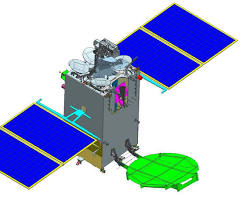The GSAT (Geosynchronous Satellite) series is a system of geosynchronous satellites developed by the Indian Space Research Organisation (ISRO) with the objective of making India self-reliant in broadcasting services. The series consists of over 20 satellites, a total of 168 transponders (out of which 95 transponders are leased out to provide services to the broadcasters) in the C, Extended C, and Ku-bands, providing services to telecommunications, television broadcasting, weather forecasting, disaster warning, and search and rescue operations.

The GSAT satellites are built on ISRO's indigenous I-2K, I-3K, and I-6K bus platforms. The satellites are equipped with a variety of transponders, which are used to provide a wide range of services, including:
• Telecommunications: The GSAT satellites provide telecommunications services to India and its neighboring countries. These services include voice, data, and video transmission.
• Television broadcasting: The GSAT satellites provide television broadcasting services to India. These services include direct-to-home (DTH) broadcasting, cable TV broadcasting, and terrestrial broadcasting.
• Weather forecasting: The GSAT satellites provide weather forecasting services to India and its neighboring countries. These services include monitoring weather conditions, predicting weather events, and providing early warning of impending disasters.
• Disaster warning: The GSAT satellites provide disaster warning services to India and its neighboring countries. These services include providing early warning of earthquakes, cyclones, floods, and other natural disasters.
• Search and rescue: The GSAT satellites provide search and rescue services to India and its neighboring countries. These services include locating and rescuing people who are lost or injured in remote areas.
The GSAT series has played a vital role in India's development. The satellites have helped to improve communication, provide access to information, and enhance disaster management capabilities. The GSAT satellites will continue to play an important role in India's future development.
Here are some of the notable GSAT satellites:
• GSAT-1: India's first experimental geostationary communication satellite, launched in 2001.
• GSAT-3: Also known as EDUSAT, India's first dedicated educational satellite, launched in 2004.
• GSAT-15: India's first satellite to carry a Ka-band transponder, launched in 2015.
• GSAT-11: India's heaviest communication satellite, launched in 2018.
• GSAT-30: India's latest communication satellite, launched in 2020.
The GSAT series is a testament to ISRO's growing capabilities in designing, building, and launching complex geostationary satellites. The satellites are playing a vital role in India's development and are also being exported to other countries.